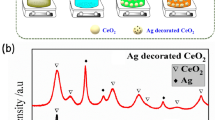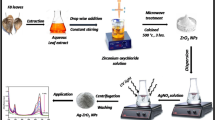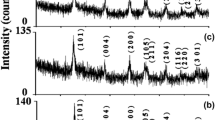Abstract
A simple co-precipitation method was adopted to synthesize the Silver-Cerium oxide (Ag–CeO2) bimetallic nanocomposite (BMNPs) using Lantana Camara extract, which can work as a reducing agent and capping agent to stabilize the desired BMNPs. The color change from yellowish brown to dark brown indicates the formation of nanoparticles, which were further identified through the absorbance peaks of UV–Vis at 284 and 428 nm for cerium oxide (CeO2) and (Ag), respectively. As-synthesized BMNPs were characterized using Fourier transform infrared spectroscopy (FTIR), Zeta potential, X-ray diffraction (XRD), Scanning electron microscopy (SEM), Energy dispersive X-ray (EDX), and Thermogravimetric analysis (TGA). The Zeta potential of Ag, CeO2, and Ag–CeO2 was found to be − 13, − 1.57, and − 1.4 mV, respectively. Moreover, the XRD results confirmed the formation of a cubic crystalline structure of BMNPs. The photocatalytic degradation efficiency of BMNPs was 85% for Eriochrome Black T by Ag–CeO2. The study provides a new route toward the green synthesis of bimetallic nanoparticles for degrading hazardous textile dyes.










Similar content being viewed by others
Availability of Data and Materials
The datasets generated during the current study are available from the corresponding author upon reasonable request.
References
Abdullah M, John P, Ahmad Z, Ashiq MN, Manzoor S, Ghori MI, Ahmed S (2021) Visible-light-driven ZnO/ZnS/MnO2 ternary nanocomposite catalyst: synthesis, characterization and photocatalytic degradation of methylene blue. Appl Nanosci 11(8):2361–2370. https://doi.org/10.1007/s13204-021-02008-x
Ahmed S (2022) CTAB-assisted fabrication of hierarchical flower-like magnesium oxide adsorbent for enhanced removal performance towards phosphate. J Magn Alloys. https://doi.org/10.1016/j.jma.2022.02.007
Ahmed S, Ahmad Z (2020) Development of hexagonal nanoscale nickel ferrite for the removal of organic pollutant via Photo-Fenton type catalytic oxidation process. Environ Nanotechnol Monitor Manag 14:100321. https://doi.org/10.1016/j.enmm.2020.100321
Ahmed S, Ahmad Z, Kumar A, Rafiq M, Vashistha VK, Ashiq MN, Kumar A (2021) Effective removal of methylene blue using nanoscale manganese oxide rods and spheres derived from different precursors of manganese. J Phys Chem Solids 155:110121. https://doi.org/10.1016/j.jpcs.2021.110121
Ahmed S, Akram MY, Kumar A, Dhir A, Ali Z, Kansal SK, Ratan JK (2022) Development of magnesium oxide@carbon fiber paper composite film for the removal of methyl orange from aqueous phase. Nanotechnol Environ Eng 7(1):49–56. https://doi.org/10.1007/s41204-021-00181-6
Ahmed S, Ashiq NM, Li D, Tang P, Leroux F, Feng Y (2019) Recent progress on adsorption materials for phosphate removal. Recent Pat Nanotechnol 13(1):3–16. https://doi.org/10.2174/1872210513666190306155245
Ahmed S, Iqbal A (2018) Synthesis of 2D magnesium oxide nanosheets: a potential material for phosphate removal. Global Chall 2(12):1800056. https://doi.org/10.1002/gch2.201800056
Ahmed S, Pan J, Ashiq MN, Li D, Tang P, Feng Y (2019) Ethylene glycol-assisted fabrication and superb adsorption capacity of hierarchical porous flower-like magnesium oxide microspheres for phosphate. Inorg Chem Front 6(8):1952–1961. https://doi.org/10.1039/C9QI00331B
Ahmed S, Rehman HU, Ali Z, Qadeer A, Haseeb A, Ajmal Z (2021) Solvent assisted synthesis of hierarchical magnesium oxide flowers for adsorption of phosphate and methyl orange: Kinetic, isotherm, thermodynamic and removal mechanism. Surf Interfaces 23:100953. https://doi.org/10.1016/j.surfin.2021.100953
Anupong W, On-uma R, Jutamas K, Joshi D, Salmen SH, Alahmadi TA, Jhanani GK (2023) Cobalt nanoparticles synthesizing potential of orange peel aqueous extract and their antimicrobial and antioxidant activity. Environ Res 216:114594. https://doi.org/10.1016/j.envres.2022.114594
Carey T, Cassidy O, Synnatschke K, Caffrey E, Garcia J, Liu S, Coleman JN (2023) High-mobility flexible transistors with low-temperature solution-processed tungsten dichalcogenides. ACS Nano 17(3):2912–2922. https://doi.org/10.1021/acsnano.2c11319
Mali C, Dhaka S, Sheetal AS, Rohini T (2023) Review on biogenic synthesis of copper nanoparticles and its potential applications. Inorg Chem Commun 149:110448. https://doi.org/10.1016/j.inoche.2023.110448
Chang Y, Dou N, Liu M, Jiang M, Men J, Cui Y, Zhu Y (2020) Efficient removal of anionic dyes from aqueous solution using CTAB and β-cyclodextrin-induced dye aggregation. J Mol Liq 309:113021
Choi Y, Jung E-Y, Lee W, Choi S, Son H, Lee Y (2023) In vitro bioanalytical assessment of the occurrence and removal of bioactive chemicals in municipal wastewater treatment plants in Korea. Sci Total Environ 858:159724. https://doi.org/10.1016/j.scitotenv.2022.159724
Das S, Panicker NJ, Rather MA, Mandal M, Sahu PP (2022) Green synthesis of cerium oxide nanoparticles using Dillenia indica aqueous extract and its anti-oxidant activity. Bull Mater Sci 46(1):3. https://doi.org/10.1007/s12034-022-02844-9
Devaraj P, Kumari P, Aarti C, Renganathan A (2013) Synthesis and characterization of silver nanoparticles using cannonball leaves and their cytotoxic activity against MCF-7 Cell Line. J Nanotechnol 2013:598328. https://doi.org/10.1155/2013/598328
Dhiman V, Kondal N, Choudhary P (2023) Bryophyllum pinnatum leaf extract mediated ZnO nanoparticles with prodigious potential for solar driven photocatalytic degradation of industrial contaminants. Environ Res 216:114751. https://doi.org/10.1016/j.envres.2022.114751
Essghaier B, Dridi R, Mottola F, Rocco L, Zid MF, Hannachi H (2023) Biosynthesis and characterization of silver nanoparticles from the extremophile plant Aeonium haworthii and their antioxidant, antimicrobial and anti-diabetic capacities. Nanomaterials. https://doi.org/10.3390/nano13010100
Farahmandjou M, Zarinkamar M, Firoozabadi T (2016) Synthesis of cerium oxide (CeO2) nanoparticles using simple CO-precipitation method. Rev Mex Fis 62:496–499
Jayarambabu N, Venkatappa Rao T, Rakesh Kumar R, Akshaykranth A, Shanker K, Suresh V (2021) Anti-hyperglycemic, pathogenic and anticancer activities of Bambusa arundinacea mediated Zinc Oxide nanoparticles. Mater Today Commun 26:101688. https://doi.org/10.1016/j.mtcomm.2020.101688
Korah BK, Mathew B (2023) Sustainable carbon quantum dots from Vitex negundo leaves as a synergistic nanoplatform for triple object sensing and anticounterfeiting applications. Mater Today Sustain 21:100273. https://doi.org/10.1016/j.mtsust.2022.100273
Mehrzad M, Behpour M, Kashi FJ (2023) Novel environmental method for enhanced biodegradation of contaminated wastewater via immobilizing nanoparticles on a new bacterial strain isolated industrial textile. J Environ Manage 325:116528. https://doi.org/10.1016/j.jenvman.2022.116528
Nadeem M, Khan R, Afridi K, Nadhman A, Ullah S, Faisal S, Abbasi BH (2020) Green synthesis of cerium oxide nanoparticles (CeO2 NPs) and their antimicrobial applications: a review. Int J Nanomed 15:5951–5961
Parimi D, Sundararajan V, Sadak O, Gunasekaran S, Sahabudeen SM, Sundaramurthy A (2019) Synthesis of positively and negatively charged CeO2 nanoparticles: investigation of the role of surface charge on growth and development of drosophila melanogaster. ACS Omega 4:104–113. https://doi.org/10.1021/acsomega.8b02747
Sajid A, Manzoor Q, Sajid A, Imran M, Khalid S, Arshad Z, Aslam F (2021) Characterization and antibacterial properties of Eriobotrya japonica extract loaded silver-nanoparticles. Curr Bioact Compd 17(7):58–63
Saravanan K, Shanthi B, Ravichandran C, Venkatachalapathy B, Sathiyanarayanan KI, Rajendran S, Suresh R (2023) Transformation of used aluminium foil food container into AlOOH nanoflakes with high catalytic activity in anionic azo dye reduction. Environ Res 218:114985. https://doi.org/10.1016/j.envres.2022.114985
Schlögl R (2015) Heterogeneous catalysis. Angew Chem Int Ed 54(11):3465–3520. https://doi.org/10.1002/anie.201410738
Senanu LD, Kranjac-Berisavljevic G, Cobbina SJ (2023) The use of local materials to remove heavy metals for household-scale drinking water treatment: a review. Environ Technol Innov 29:103005. https://doi.org/10.1016/j.eti.2023.103005
Shen B, Li W, Wang Y, Cheng S, Wang X, Zhu L, Jiang L (2023) Rapid capture and killing of bacteria by lyophilized nFeS-Hydrogel for improved healing of infected wounds. Biomater Adv 144:213207. https://doi.org/10.1016/j.bioadv.2022.213207
Siddiqi KS, Husen A, Rao RAK (2018) A review on biosynthesis of silver nanoparticles and their biocidal properties. J Nanobiotechnol 16(1):14. https://doi.org/10.1186/s12951-018-0334-5
Silva MR, Tita V, De Medeiros R (2023) Influence of the geometric parameters on the effective properties of piezoelectric composite sensors using real measurements and a new RVE. Compos Struct 303:116292. https://doi.org/10.1016/j.compstruct.2022.116292
Thamarai Selvi S, Sunitha R, Ammayappan L, Prakash C (2023) Impact of chemical treatment on surface modification of agave americana fibres for composite application—a futuristic approach. J Natl Fib 20(1):2142726. https://doi.org/10.1080/15440478.2022.2142726
Ur Rehman H, Ahmed S, Ur Rahman M, Mehmood Muhammad S (2022) Arsenic contamination, induced symptoms, and health risk assessment in groundwater of Lahore, Pakistan. Environ Sci Pollut Res 29(33):49796–49807. https://doi.org/10.1007/s11356-022-19405-6
Vidyasagar P, Raj R, Singh SK, Singh M (2023) Green synthesis of silver nanoparticles: methods, biological applications, delivery and toxicity. Mater Adv. https://doi.org/10.1039/D2MA01105K
Wang J, Fan D, Zhang L, Yang D, Qiu X, Lin X (2023) Lignin-derived hierarchical porous carbon with high surface area and interconnected pores for efficient antibiotics adsorption. Chem Eng J 454:139789. https://doi.org/10.1016/j.cej.2022.139789
Wang Q, Wang B, Shi D, Li F, Ling D (2023) Cerium oxide nanoparticles-based optical biosensors for biomedical applications. Adv Sens Res 2(3):2200065. https://doi.org/10.1002/adsr.202200065
Wang Q, Zhang P, Zhao W, Li Y, Jiang Y, Rui Y, Lynch I (2023) Interplay of metal-based nanoparticles with plant rhizosphere microenvironment: implications for nanosafety and nano-enabled sustainable agriculture. Environ Sci Nano 10(2):372–392. https://doi.org/10.1039/D2EN00803C
Xie L, Du T, Wang J, Ma Y, Ni Y, Liu Z, Wang J (2021) Recent advances on heterojunction-based photocatalysts for the degradation of persistent organic pollutants. Chem Eng J 426:130617. https://doi.org/10.1016/j.cej.2021.130617
Yin C, Li X, Wang Y, Liang Y, Zhou S, Zhao P, Huang W (2021) Organic semiconducting macromolecular dyes for nir-ii photoacoustic imaging and photothermal therapy. Adv Funct Mater 31(37):2104650. https://doi.org/10.1002/adfm.202104650
Zhang H, Zhang F, Sun W, Chen D, Chen J, Wang R, Zhang C (2023) The effects of hydroxyl on selective separation of chalcopyrite from pyrite: a mechanism study. Appl Surf Sci 608:154963. https://doi.org/10.1016/j.apsusc.2022.154963
Zhao J, Gao N, Xu J, Zhu X, Ling G, Zhang P (2023) Novel strategies in melanoma treatment using silver nanoparticles. Cancer Lett 561:216148. https://doi.org/10.1016/j.canlet.2023.216148
Acknowledgements
The authors acknowledge the Department of Chemistry, The University of Lahore, for providing facilities to complete this research work.
Funding
No funding was received.
Author information
Authors and Affiliations
Corresponding authors
Ethics declarations
Conflict of Interest
All authors have no conflict of interest.
Ethical Approval
Not applicable.
Rights and permissions
Springer Nature or its licensor (e.g. a society or other partner) holds exclusive rights to this article under a publishing agreement with the author(s) or other rightsholder(s); author self-archiving of the accepted manuscript version of this article is solely governed by the terms of such publishing agreement and applicable law.
About this article
Cite this article
Sajid, A., Javed, R., Manzoor, Q. et al. Development of Ag–CeO2 Bimetallic Nanocomposite for Visible-Light-induced Photocatalytic Degradation of Eriochrome Black T. Chemistry Africa 7, 2103–2110 (2024). https://doi.org/10.1007/s42250-023-00864-4
Accepted:
Published:
Issue Date:
DOI: https://doi.org/10.1007/s42250-023-00864-4




